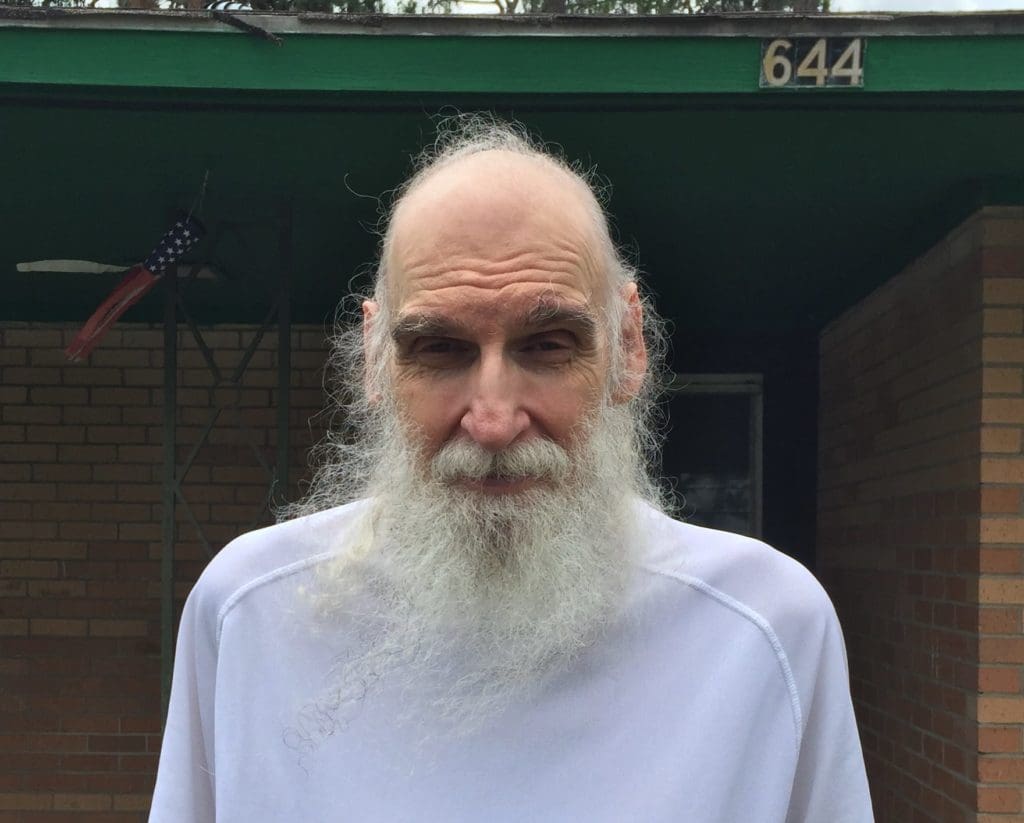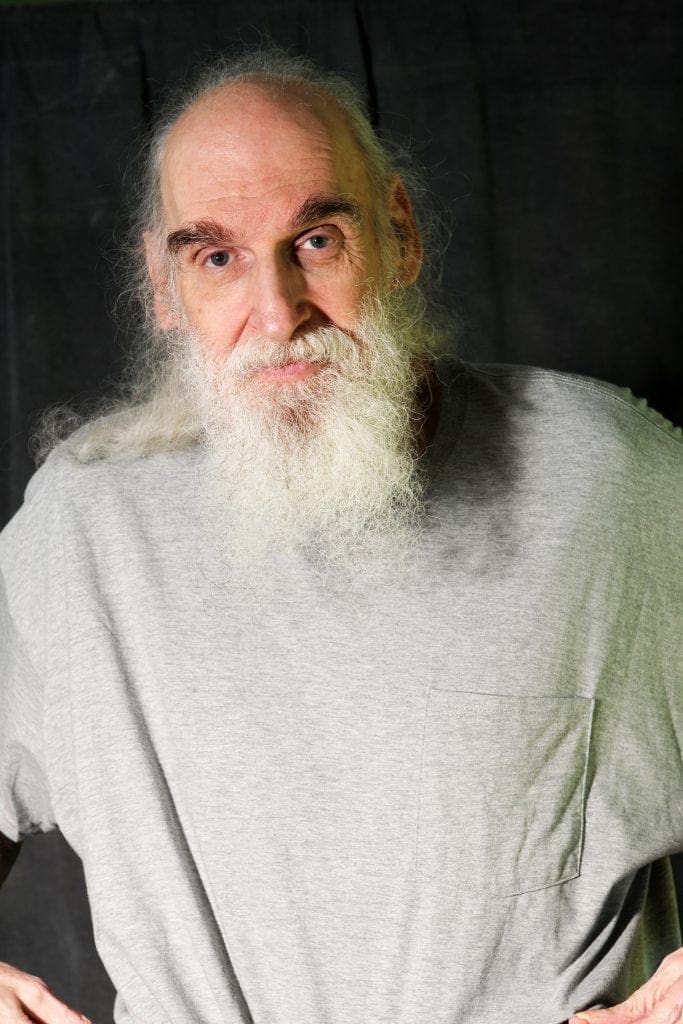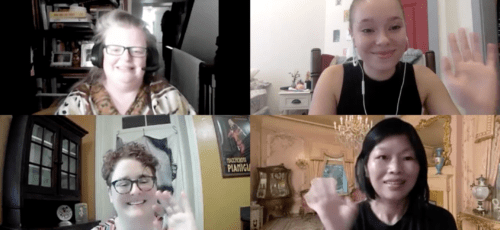Tall Tales: An Interview with Clayton Storyteller
 Clayton Storyteller hails from Brunswick, Georgia, and has been telling stories for decades in the south, and now, in Philadelphia. He worked as a performer in Las Vegas, backpacked for two months around Europe, and is a two-time USDA Nutrition Study guinea pig. In his Fringe Festival Show Don’t be Cruel to Your Puppy…Lemme Give YOU A Twisted Tale, he has prepared three different programs of stories, each a mix of all kinds of tales. “Program A has westerns and ghost stories, B has science fiction, and C has darker, grittier, more violent tales, plus strange romances,” says Clayton. “Some tales are wilder, some milder, but they have no political or philosophical point, save entertainment.” Each program ends with his signature tale, “A Safe Sex Story,” which will also be available as an illustrated chapbook. He’ll be telling stories beginning before the official Fringe Festival kick-off on September 5th, and will continue to tell them every night afterwards until September 23rd, from 5:30 to 6:10 pm at the Philly Improv Theater. Audiences can come and hear his wild stories as an appetizer before the many events at the Philly Improv Theater and many locations in the nearby area. He hasn’t been to Philly since passing through on a 7th grade school trip, “a half-century ago.” I talked with Clayton about his life and work, and how he happily ended up as a newcomer to the 2017 Fringe Festival.
Clayton Storyteller hails from Brunswick, Georgia, and has been telling stories for decades in the south, and now, in Philadelphia. He worked as a performer in Las Vegas, backpacked for two months around Europe, and is a two-time USDA Nutrition Study guinea pig. In his Fringe Festival Show Don’t be Cruel to Your Puppy…Lemme Give YOU A Twisted Tale, he has prepared three different programs of stories, each a mix of all kinds of tales. “Program A has westerns and ghost stories, B has science fiction, and C has darker, grittier, more violent tales, plus strange romances,” says Clayton. “Some tales are wilder, some milder, but they have no political or philosophical point, save entertainment.” Each program ends with his signature tale, “A Safe Sex Story,” which will also be available as an illustrated chapbook. He’ll be telling stories beginning before the official Fringe Festival kick-off on September 5th, and will continue to tell them every night afterwards until September 23rd, from 5:30 to 6:10 pm at the Philly Improv Theater. Audiences can come and hear his wild stories as an appetizer before the many events at the Philly Improv Theater and many locations in the nearby area. He hasn’t been to Philly since passing through on a 7th grade school trip, “a half-century ago.” I talked with Clayton about his life and work, and how he happily ended up as a newcomer to the 2017 Fringe Festival.
FringeArts: Where were you born? Where did you grow up? Were there storytellers in your family?
Clayton Storyteller: I was born in Tampa. We moved some miles south to Bradenton when I was a toddler, then at age eight up to metro Atlanta, where I spent most my life (so far). I’ve been in Brunswick, Georgia, for last twenty years and enjoy it immensely. My southerner father went to Detroit for work and married a Michigan bride. We didn’t have any Deep South or Appalachian tradition of storytelling in our family. What fostered my love of stories was my mother, who was an avid reader and passed that on to my brother and me. Erle Stanley Gardner was her favorite author. A golden memory of my childhood was looking at black-and-white photos on a wooden stereopticon in the loft of an old library.
FringeArts: How did you learn to tell stories, and when did you start telling them?
Clayton Storyteller: Literature was always my favorite class. In my five-grade high school I wrote dark, dreck poetry—copies of which fortunately no longer exist—and funny stories. I was flattered when I was an 8th-grade “sub-freshman” and a 9th-grade girl in my science class—name sadly disremembered—liked one of these stories enough to copy it front and back on a piece of paper during a study period. Our friends in the desks around us laughed at this, but she scribbled on, repeating, “But it’s so funny!” This was some nonsense about a blackboard named Charlie who was actually green and the silliness goes on from there and is also now lost. That was the girl’s only interest in me, alas! I was a shy kid. My interest in actually telling stories started when I joined Toastmasters in the mid-80s. I also joined the Southern Order of Storytellers about then, which had several “cluster group” meetings in metro Atlanta neighborhoods, where aspiring storytellers could practice stories and get feedback. I started writing my own stories for storytelling, eventually working into all verse tales.
FringeArts: What do you like telling stories about? Who do you most often tell them too?
Clayton Storyteller: I started with humorous stories and still like telling them. I can’t say I like writing them, but I like having them written, and the only way that happens is to write them. In the early 90s I became interested in dark stories and started writing and telling them a bit, but I was worried about what people might think of me that I was interested in that sort of thing. Again, it was Toastmasters that helped me with this. A Toastmasters Fall Conference had a late-evening Halloween stories event and the organizer invited me to participate. I prefaced one of my darker tales, which was slightly risqué as well, with not an apology, but an explanation/justification. The audience thought that was funny, so I went ahead and told it, got a good response and nobody got upset. It was when I was in North Dakota in 1994 that I had an opportunity to expand my range of stories some more. In the first half of ’91, then second half of ’94, I was a residential guinea pig at the USDA Human Nutrition Research Center in Grand Forks. They rotated studies for demographics with different nutritional needs—the studies I was in were for males 20–40—was to set RDAs for trace elements: copper in ’91, manganese in ’94. We ate the same diet every day—only that food and every crumb of it—and all “output” was kept for later analysis, in a jug or plastic bag in a half-fridge under the counter of each volunteer’s bathroom. The fridge had another door opening onto the hallway, and every morning a worker from the lab downstairs came up on the elevator and wheeled a cart around the hallway, cheerfully taking crap from everybody. Anyway, part of the way they recruited guinea pigs—actually called “volunteers.” though we were paid a little—was putting ads in Writer’s Digest saying: “Want to write the Great American Novel?” Because besides the meals and what little testing volunteers had to do, their time is pretty much their own, and management wanted people there to have something to occupy themselves so they wouldn’t get in others’ hair and create conflict. We had a handful of writers in our study and formed a critique group. I didn’t write the Great American Novel, but I wrote more stories than I would’ve otherwise.
As for my performances, one of my most satisfying was a pro bono telling—seems a lot of my performances are “pro bono”) for the Peach Cobbler teen parent group organized by the GA Dept. of Family and Children’s Services. By teen parent group I mean young women, because the guys were largely nowhere in the picture. Again, the Toastmasters connection was important, as a club member who worked for DFACS with this group turned me on to the opportunity. This was just after I’d written “A Safe Sex Story,” then obscurely titled “Frat House Rhapsody,” and that the young women enjoyed it heartened me and showed me that I could entertain and do some good. I’ve told stories for the Atlanta Bureau of Cultural Affairs, told a silly Christmas mini-program for businesses in Grand Forks, and even told for a church group, as well as other clients. My tales are meant for teens and adults. I’ll tell for anyone who’ll listen, but I prefer paid gigs, because I can’t live on pro bono.
FringeArts: Are your stories true?
Clayton Storyteller: When I was a kid, I used to get spanked for telling stories. Unfortunately, these days I’m rarely able to arrange that sort of trade. Well, all my stories are lies. Or let’s say instead that they’re made up. Not to denigrate them, but they’re basically cartoons—dark and violent, silly or racy cartoons—or a mix of two or all three of those.
FringeArts: How do you develop a story over time?
Clayton Storyteller: “Over time” is the operative phrase here. I often have story ideas in my head for months or usually years before getting around to working on them. Though I work in verse, I’m Clayton Storyteller, not Clayton Poet. When the story’s cooking in my head, I’m getting an idea of rhymes to be used, phrasing, rhyme scheme, and stanza length. Those, along with sentence length and structure, can determine how fast or slow the story “tells.” For my dark humor story, “Murder Could Hurt Her,” I invented a rhyme scheme: AABCDDBC. (Someone else may have invented it first, but I haven’t seen it.) The A and D lines are very short, Bs are medium and Cs a little longer. This moves the story along pretty well. My short stalker story, “Predatory Intentions” has an AABAB scheme. A storyteller in my SOS cluster group suggested that may be too jaunty for such menacing subject matter. I considered her advice but decided to leave it as is. My two westerns, “My Gray-eyed Girl” and “The Schoolmarm from Massachusetts,” are both ABAB ballad form (though told, not sung), for a slow-to-medium pace. Three of my four ghost stories are in couplets, but different line length and rhythm—and different narratives, of course—distinguish the different tales.
In writing my stories, I need to keep track of rhyme, rhythm, rhyme scheme, catchy phrases to carry the darkness, humor and/or raciness. And in crafting the tale, I have to avoid being too literary and writing for the page — the story must work primarily in the air and in the ear. I also have a tendency to overindulge in alliteration, so I try to keep that in check so I don’t set traps to trip my tongue in the telling. I need to keep all those things in mind, plus the story. It’s almost like being one of those acts on the old Ed Sullivan Show and trying to keep a half dozen plates spinning on poles at the same time, but in ultra-ultra-slo-motion.
FringeArts: Who are some artists that you’ve looked up to?
Clayton Storyteller: I like cowboy poets like Waddie Mitchell and Baxter Black. I attended concerts by nationally known storytellers Jay O’Callahan, Bill Harley, and Donald Davis, and learned much from their technique. During my time in the Atlanta area with the Southern Order of Storytellers, Nancy Kavanaugh, Carmen Deedy, Fiona Page, and Lloyd Arneach, among others, influenced me. Among more “adult” performers, comedian/songwriter/storyteller Stephen Lynch really appeals to me. The favorite authors of my youth were sci-fi writers Ray Bradbury, Robert Heinlein, Robert Silverberg, and Kurt Vonnegut. In adulthood, it’s been Louis L’Amour and Georges Simenon.
FringeArts: Do you consider yourself a comedian?
Clayton Storyteller: I was one of many Toastmasters and storytellers who took Jeff Justice’s Comedy Workshop in Atlanta. It helped me a lot in incorporating humor into my stories. But I never had any desire to try to break into comedy professionally. As I’m not Clayton Poet, neither am I Clayton Comedian. But when I listed Spoken Word as my primary category for FringeArts Fest, I put down Comedy/Improv as my secondary one. Though I’m performing at the Philly Improv Theater Second Stage, I’m definitely not improv-ing (though I hope to be improving). I tell several short stories during my forty-minute program, with some topical, evocative or often humorous comments in between—just how humorous remains to be seen. Almost all of my stories, even the dark ones, have some humor in them.
 FringeArts: What have you been up to apart from storytelling?
FringeArts: What have you been up to apart from storytelling?
Clayton Storyteller: I’m not currently working. I was on workers comp for a long time but that’s run out. I’m hoping to become a regular at a handful of fringes. I hope also to become a safe sex chapbook publishing mogul, so long as it doesn’t interfere with my Important TV Watching. I backpacked Europe in the Summer of ’79. I got to see interesting sights, meet nice folks and practice my rudimentary Spanish. (Got to practice my English too in London—it’s somewhat interchangeable with Amurcan but not in all instances.) This was before I got into storytelling. All twenty-odd stories I’m bringing to the fringe have US settings—most general, but some specific as to region. That’s the westerns, plus ghost stories set in Appalachia or the border states (us poor haunted southerners!). I’m in the middle of crafting my first European-set story, but set it aside to prepare for the festival.
I worked for Trust Company Bank, which merged with Sun Bank to become SunTrust for nine years and four months from 1980 to 1990. They now pay me $200 a month to not work and I like that just fine. I worked in the operations center in downtown Atlanta running a several-hundred-thousand-
FringeArts: What made you decide to do the Philly Fringe?
Clayton Storyteller: Fringes came into my radar as being a good match for my material. I looked into several across the US and Canada and applied to some. Then I realized that I still wasn’t in shape for an ambitious fringe tour, so I pulled out of the few far-flung fringes I’d been accepted to, and decided to concentrate only on those accessible by East Coast Amtrak. I signed up with FringeArts Fest, got a venue, booked a hostel and did the other things necessary to get up there (or “here” to ya’ll) and put on a show. If I don’t become an exploding supernova or clunking piece of space junk in September I hope to be back next year, as well as adding a few fringes in other cities. “A Safe Sex Story” is coming out as a chapbook illustrated by Tess Bowens, a student at Savannah College of Art and Design, who was a joy to work with. There’s a PPD stuck on the inside the book. PPD stands for “personal protective device” and is my euphemism to not say condom condom condom all the time when I’m talking about the story. PPDs include hard hats, safety glasses and the like. That the abbreviation is more obscure than I thought shows I should probably just go ahead and say condom.
A half century ago, my 7th grade school patrol train trip to DC and NYC only passed through Philadelphia in the night up and back. Those were my only times in the city. I’m looking forward to meeting folks as I make a long stop this time. In Atlanta and in Grand Forks, and even in my stay in Las Vegas in the late Aughties when I was feeling somewhat better, although I came in just as the recession hit, storytelling has been fun, but not always lucrative. Getting into the occasional fringe should allow me to tell to audiences who won’t be upset that I’m not offering traditional family-friendly Uncle Remus stories and Jack tales and to sell “A Safe Sex Story” chapbooks afterward, and between fringes to still do my Important TV Watching while epoxying condoms into chapbooks to sell over the internet.
FringeArts: What should audiences expect upon coming to your show?
Clayton Storyteller: If audiences come to my show expecting to entertained, I’ll entertain them. My tales are short—between one-and-a-half to eight-and-a-half minutes—and are a mix of period pieces and modern: westerns, ghost stories, science fiction and fantasy, romances and relationship stories (more of the latter than the former), creepy tales, dark and light nonsense pieces, and unclassifiable storylike things. I don’t think I can “out-outrageous” many of the other shows, but I’m rehearsing hard to get my programs in the best shape possible. Attend any of my programs and you’ll see and hear a show that’s unlike anything else that’s being presented at FringeArts Fest.
Don’t Be Cruel to Your Puppy…Lemme Give YOU a Twisted Tale
Clayton Storyteller
$10 / 40 minutes
Philly Improv Theater
2030 Sansom St
Sept 5–23 at 5:30pm
— Isabella Siegel
Photos: Nancy J. Reynolds




